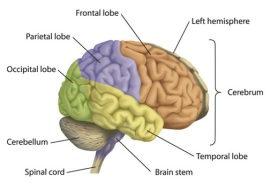This is the third in a series on Understanding Attention Deficit/Hyperactivity Disorder (ADHD). Today we look closer at the nature of attentiveness and its location in the brain.
 Attention is the ability of the brain to selectively concentrate on one aspect of the environment while ignoring other things. There are two types of attention in two separate regions of the brain. The prefrontal cortex (directly behind the forehead) is in charge of willful concentration; if you are studying for a test or writing a novel, the impetus and the orders come from there. But if there is a sudden, riveting event – the attack of a tiger or the scream of a child – it is the parietal cortex (behind the ear) that is activated. Scientists have learned that these two brain regions sustain concentration when the neurons emit pulses of electricity at specific rates – faster frequencies for the automatic processing of the parietal region, slower frequencies for the deliberate, intentional work of the prefrontal region.
Attention is the ability of the brain to selectively concentrate on one aspect of the environment while ignoring other things. There are two types of attention in two separate regions of the brain. The prefrontal cortex (directly behind the forehead) is in charge of willful concentration; if you are studying for a test or writing a novel, the impetus and the orders come from there. But if there is a sudden, riveting event – the attack of a tiger or the scream of a child – it is the parietal cortex (behind the ear) that is activated. Scientists have learned that these two brain regions sustain concentration when the neurons emit pulses of electricity at specific rates – faster frequencies for the automatic processing of the parietal region, slower frequencies for the deliberate, intentional work of the prefrontal region.
ADHD medications increase activity in the prefrontal cortex and attention-related areas of the parietal cortex during challenging mental tasks; these are the same areas that the study I cited yesterday demonstrated to be underactive in ADHD brains. However, there may be different forms of ADHD and there is an urgent need to develop more effective drugs to regulate these two different frequencies in order to improve attention for specific forms of the disorder.